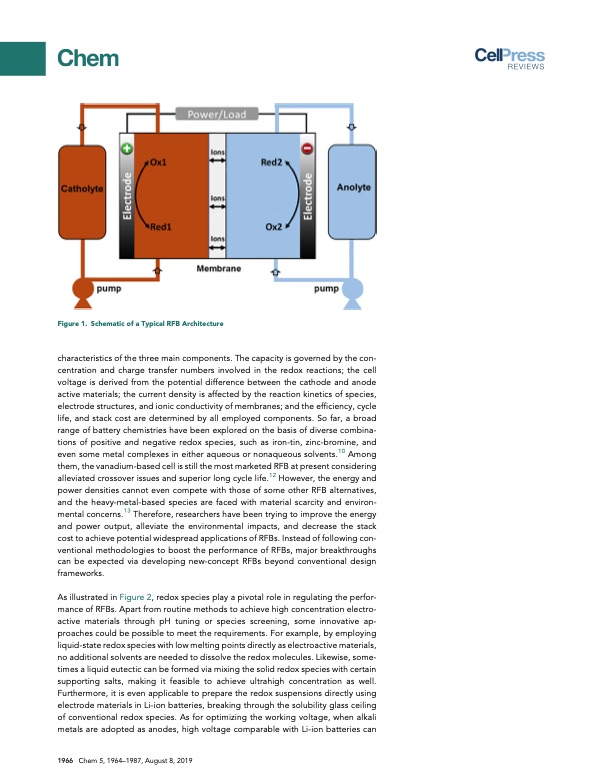
PDF Publication Title:
Text from PDF Page: 003
Figure 1. Schematic of a Typical RFB Architecture characteristics of the three main components. The capacity is governed by the con- centration and charge transfer numbers involved in the redox reactions; the cell voltage is derived from the potential difference between the cathode and anode active materials; the current density is affected by the reaction kinetics of species, electrode structures, and ionic conductivity of membranes; and the efficiency, cycle life, and stack cost are determined by all employed components. So far, a broad range of battery chemistries have been explored on the basis of diverse combina- tions of positive and negative redox species, such as iron-tin, zinc-bromine, and even some metal complexes in either aqueous or nonaqueous solvents.10 Among them, the vanadium-based cell is still the most marketed RFB at present considering alleviated crossover issues and superior long cycle life.12 However, the energy and power densities cannot even compete with those of some other RFB alternatives, and the heavy-metal-based species are faced with material scarcity and environ- mental concerns.13 Therefore, researchers have been trying to improve the energy and power output, alleviate the environmental impacts, and decrease the stack cost to achieve potential widespread applications of RFBs. Instead of following con- ventional methodologies to boost the performance of RFBs, major breakthroughs can be expected via developing new-concept RFBs beyond conventional design frameworks. As illustrated in Figure 2, redox species play a pivotal role in regulating the perfor- mance of RFBs. Apart from routine methods to achieve high concentration electro- active materials through pH tuning or species screening, some innovative ap- proaches could be possible to meet the requirements. For example, by employing liquid-state redox species with low melting points directly as electroactive materials, no additional solvents are needed to dissolve the redox molecules. Likewise, some- times a liquid eutectic can be formed via mixing the solid redox species with certain supporting salts, making it feasible to achieve ultrahigh concentration as well. Furthermore, it is even applicable to prepare the redox suspensions directly using electrode materials in Li-ion batteries, breaking through the solubility glass ceiling of conventional redox species. As for optimizing the working voltage, when alkali metals are adopted as anodes, high voltage comparable with Li-ion batteries can 1966 Chem 5, 1964–1987, August 8, 2019PDF Image | Development of Redox Flow Batteries Based on New Chemistries

PDF Search Title:
Development of Redox Flow Batteries Based on New ChemistriesOriginal File Name Searched:
PIIS2451929419302207.pdfDIY PDF Search: Google It | Yahoo | Bing
Salgenx Redox Flow Battery Technology: Salt water flow battery technology with low cost and great energy density that can be used for power storage and thermal storage. Let us de-risk your production using our license. Our aqueous flow battery is less cost than Tesla Megapack and available faster. Redox flow battery. No membrane needed like with Vanadium, or Bromine. Salgenx flow battery
| CONTACT TEL: 608-238-6001 Email: greg@salgenx.com | RSS | AMP |